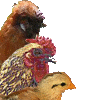MAREKS DISEASE (MD), is a common virus that causes internal lesions (tumors), and kills more birds than any other disease. It is so common that you should assume you have it in your flock, even if you detect no evidence.
Mareks is a member of the herpesvirus family of viruses. It is also known as 'Range Paralysis'. Mareks is spread through airborne feather dander so microscopic that it can spread from one farm to another via the wind, even when no human or bird contact is made between the two farms. The virus enters through the bird's respiratory tract.
The turkey version is Herpes Virus Turkey (HVT), and the waterfowl version is known as Duck Virus Enteritis (or DVE). All three are from the same family of viruses.
It's not common for MD, HVT, and DVE to cross over between chickens, turkeys, and ducks kept together, but it has happened.
The study of Mareks Disease in poultry is exciting because it has had a profound effect on cancer research in all species, including human. And the Mareks vaccine for chickens was the first time medical science was able to produce an effective cancer vaccine for any species.
There are a few different types of Mareks in chickens. The most common are eye, visceral (tumor producing), and nerve.
The nerve version is known by some Fanciers as 'down in the leg', and symptoms range from slight to severe paralysis in the wings, legs, or neck, and usually results in death from trampling by other chickens, and/or the inability to get to food and water. There can be 'transient' paralysis that disappears after a few days, such as a dropped wing that suddenly corrects itself. In the eye version, you'll detect an irregularly shaped pupil, cloudy eye ('gray eye'), or sensitivity to light. It can result in blindness. The visceral version should be considered when a bird is just generally 'wasting'.
Mareks is extremely contagious but does not spread vertically (to the egg). Youngsters should develop a natural immunity (called 'age resistance'), by the time they're five months old. This is one of the reasons it is important to raise your youngsters separately from your oldsters. The older birds that have encountered Mareks and have managed to survive are carriers. New birds coming in from other flocks are always potential carriers.
Mareks usually hits between 5 and 25 weeks of age, but can appear even later if the bird had 'latent' MD and is substantially stressed. However, if the bird is a few years old, I would suspect a similar disease called Lymphoid Leukosis (which does pass to the egg). Both diseases will produce internal lesions (or tumors), detectable upon post mortem examination, but LL does not produce paralysis.
Since it is so difficult to control your birds' exposure to Mareks, (showing, bringing in new birds, airborne spread from other farms), the best course is prevention. That starts with completely sanitizing your brooders. Then consider the Mareks vaccine, which is available in a freeze-dried form through a few of the mail-order suppliers, and is easy to administer to day-old chicks. The downside is that you have to administer the vaccine within one-half hour of mixing it with the fluid it comes with (diluent), and you have to plan your hatching to accommodate the 'all-or-none' vaccination within a day or two of hatch. (After one hour of mixing the Mareks vaccine, the active virus dies and the vaccine becomes ineffective.)
You'll inject the vaccine under the skin at the back of the neck (subtecaneously). Be careful though, you could stick right through to the other side and vaccinate the floor instead of the chick!
There are certain 'B factors' contained in the blood of some chickens that make them resistant to Mareks. If you have access to a lab for 'B type' blood testing, 'B factor' birds are desirable for breeding for a 'Mareks-free' flock.
Overall, the easiest way by keep Mareks out of your flock (but not the most effective), is to promote 'age resistance' by keeping your youngsters separate from the adults and away from the poultry shows until they're over 5 months old.






 Højpatogen fugleinfluenza...
Fra Tomzen
Højpatogen fugleinfluenza...
Fra Tomzen  Hvor i DK bor du?
Fra Tomzen
Hvor i DK bor du?
Fra Tomzen  Naboens høns
Fra Tomzen
Naboens høns
Fra Tomzen